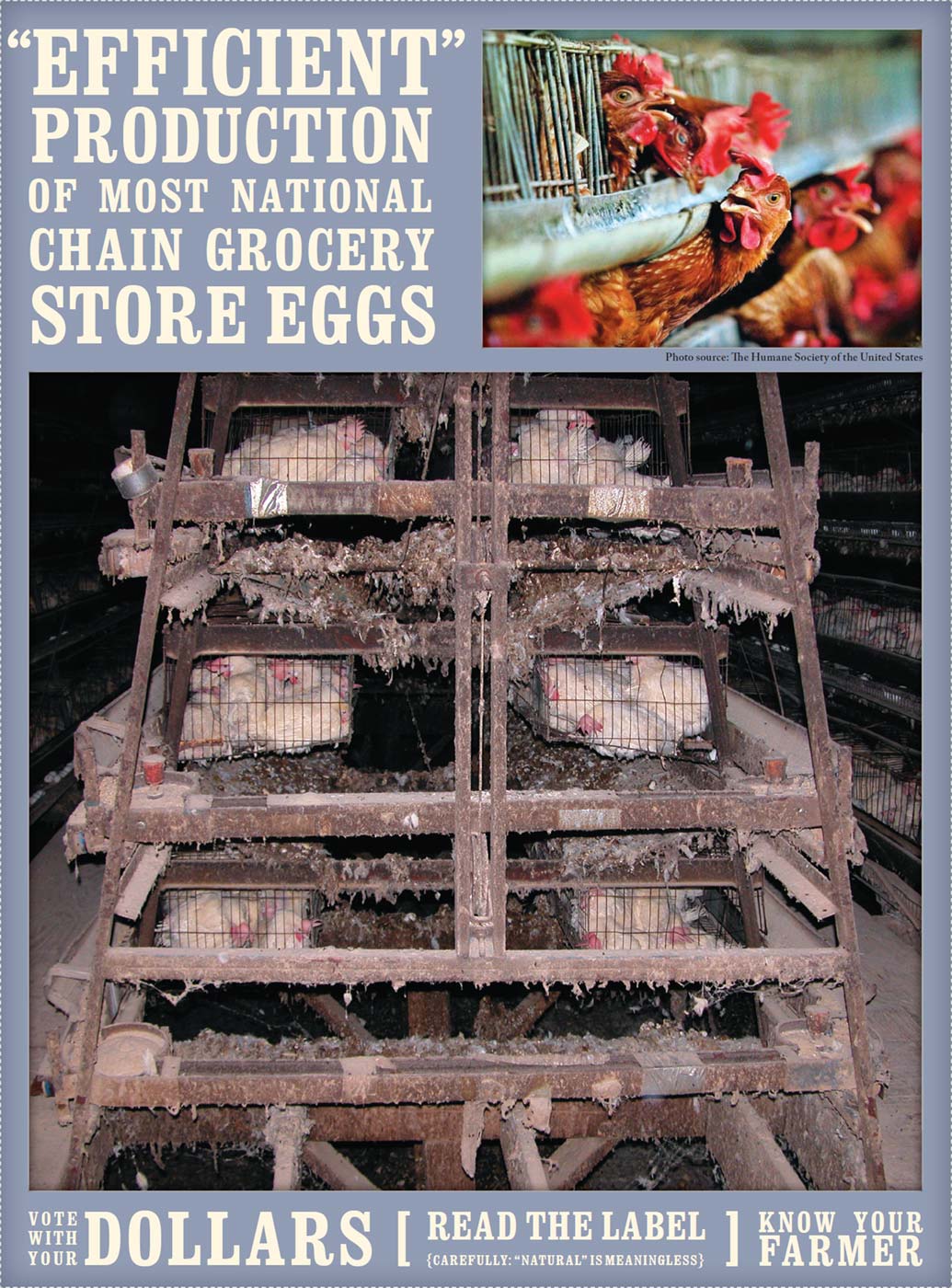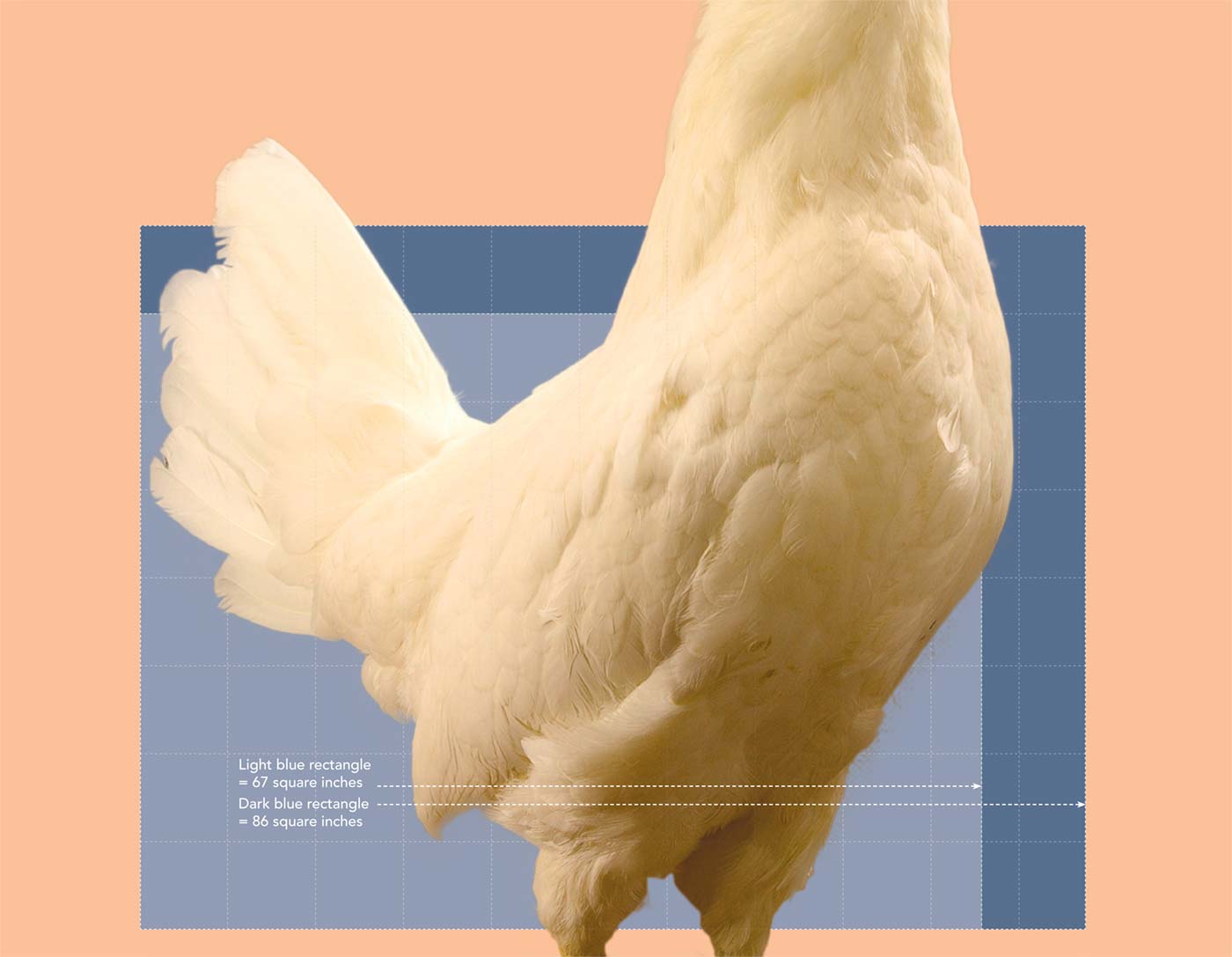The Problem of Efficiency
“… depending on the size of the laying hen and the size and style of the cage, hens needed space of 67 to 86 inches per bird.” —United Egg Producers Certified Guidelines on Housing, Space, Feed & Water
In the summer of 2010 I was part of a group that toured a concentrated animal feeding operation (CAFO) in western Kentucky and wrote about it for this magazine. After a lifetime of living in a farm community surrounded by livestock farmers — and being one myself — the experience of seeing animals, and people, treated like factory parts was, to say the least, eye opening, and has stayed on my mind ever since.
The farmers I grew up around were traditional farmers in the sense that his or her farm was their home, their life and their way of life — not just a “workplace” or “job.” For that reason the farm produces a cash income but that is not all it produces and some of what it produces cannot be itemized at tax time.
What are those things? Fertility, health, sustainability, satisfaction, interest, self- reliance and contentment are a few that come to mind. I think that I could make a case for all of those contributing to economic health as well.
But what I want to talk about here is the difference between the traditional Kentucky farm and the CAFO I saw a couple of years ago. We must try to understand how we have gotten to a place in our history that such a horror could be even considered, much less used, by agribusiness leaders and schools of agriculture as models of efficiency. And, we must try to understand how we have allowed “affection” to be replaced by “cheap and efficient.”
The American Heritage Dictionary defines the word efficient this way: 1. Acting to produce an effect with a minimum of waste or effort. 2. Exhibiting a high ratio of output to input. I don’t have academic credentials from schools of business or economics to take this subject as an expert, but I do know that to come up with the right answer to a problem one must deal with the whole problem. And, because the definitions I listed above have been used to define a “successful” farm, the result has been that efficiency has ruled the day. Farms like I saw summer before last have a sort of legitimacy that “stupidity in concentration,” as my father calls it, should never have. In fact, our government, if it cares about the health of its people and land, should be much concerned about these animal factories. Instead, these CAFOs have received government encouragement and incentives.
As a culture we have accepted the fact that cheap and efficient is good — without giving, evidently, any thought to anything else. It is useful to think about how we got here. After World War II the agriculture in this country was pretty good and was promising. For the most part it was reliant on solar power, meaning that people and animals did most of the work. There were agricultural communities that shared and passed down knowledge, shared work and were supported by small towns that supplied things that farmers needed and couldn’t produce. The towns served as marketplaces for the products farmers had to sell. We could have and should have continued and improved those local economies and communities. We did not, and among the many losses of that modern agenda is the displacement of nearly the entire farming population. (It should be pointed out that if we had improved and supported local economies and communities we would have had no need for CAFOs. We would have had a supply of “sustainably produced” meat coming from a healthy, economically stable countryside.) My uncle John M. Berry Jr. said in a speech given in 1989, “The devastation suffered by rural America is not an accident; it is not the result of changing times or technological development; it is not the result of uncontrollable economic circumstances; it is a crisis by design.” And now we see abominations like CAFOs as part of the tragedy of industrial agriculture “design.”

My uncle’s quote strengthens me, however bad the results of the design he speaks of have been. As a culture ours has been much too quick to believe that the loss of what is precious has been and is inevitable, and furthermore that we must get out of the way of “progress.”
This “crisis by design” has not been inevitable and it has served no one and nothing as much as the corporations that have supplied the necessary machines, fuels and chemicals — and the corporations that have bought cheap and sold high the products that, as a result of this agenda, have been increasingly expensive for farmers to produce.
More and more of us are rejecting the notion that poisoned land, air and water is a fair price to pay for cheap food. We don’t believe that any human or animal should live in or work in the horror that is a CAFO. We must insist that the whole is considered. This is true accounting and Wes Jackson calls it the science of the future. It means that as a culture we would decide that we are no longer satisfied with the practice of short-term economics, the economics of self-interest and greed. We would no longer be willing to accumulate large “externalized” costs, which are charged to the future.
We also must become people who can name and know how to value what is precious and that calls for affection.
Would citizens with affection for their homeland sacrifice its environmental health, its fertility, and some of its people to a food system in which CAFOs play an integral part? Only if those people had accepted that an efficient food system that sacrifices what is precious for what is cheap is worth the cost. Some people have accepted that trade knowingly, and many more unknowingly. But ignorance is finally no excuse. The evidence of our self-destruction is everywhere and we must become a people who can see what is happening.
My husband and I have always been livestock farmers, as have been many generations of both our families. We have raised dairy cows, hogs, chickens, sheep and beef cattle on the place we have lived for the past 30 years. These animals have not been pets and we have raised them to sell to markets and to eat ourselves. That said, all of the animals that have been in our care over the years have been treated with affection, which is to say their health and well-being is always on our minds. Their health is tied to the health of our place, which is tied to our own health and the health of our customers and to the community we live in. I don’t remember “”learning” these things. We were lucky enough to grow up in and then join a fairly healthy agricultural community and I admired and loved many very good farmers. They were people driven by passionate interest in their places. I was taught by example and words. That passing down of essential knowledge is what our culture has lost and what we must regain. To do this we must use a standard that is more complete than the “bottom line”; we must become a people capable of affection for our homeland and for each other.





